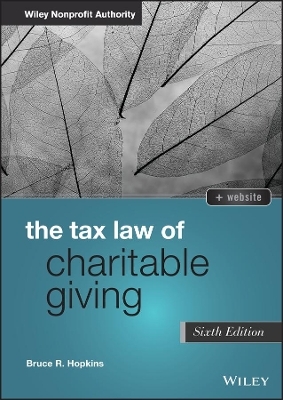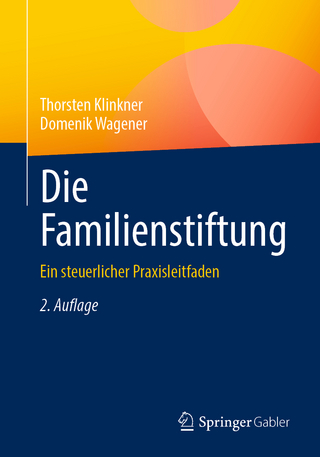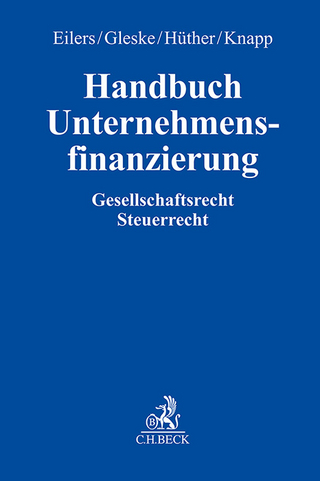
The Tax Law of Charitable Giving
John Wiley & Sons Inc (Verlag)
978-1-119-75600-2 (ISBN)
Discover a fully updated and comprehensive reference on US charitable tax law from a leading authority
As United States charitable tax law becomes ever more complex and byzantine, the need for a one-stop resource on foundational and advanced topics in this practice area has become acute. The comprehensively revised Sixth Edition of The Tax Law of Charitable Giving fills this niche. The book offers readers a fulsome, authoritative, and well-organized description of modern US tax laws on charitable giving
Ranging over the basics of US charitable giving law to the intricate details of contributions of various types of property and international giving, this accomplished nonprofit lawyer, professor, and author delves deeply into a wide variety of subjects concerning deductible (and nondeductible) charitable giving. In addition to fundamental topics such as the definition of gift and percentage limitations on charitable deductions, readers will learn about planned giving, donor-advised funds, the substantiation and appraisal requirements, reporting and disclosure laws, valuation pricinples, tax penalties, and more.
Ideal for lawyers, accountants, and other financial professionals who advise clients on charitable giving and tax matters, The Tax Law of Charitable Giving provides an authoritative reference on all aspects of philanthropy and federal tax law.
BRUCE R. HOPKINS is the principal in the Bruce R. Hopkins Law Firm, LLC, and the Professor from Practice at the Kansas University School of Law. He is the author of over forty books, including The Law of Tax-Exempt Organizations, Twelfth Edition, The Law of Fundraising, Fifth Edition, and The Tax Law of Private Foundations, Fifth Edition.
Preface xv
Book Citations xix
Part One Introduction to the Tax Law of Charitable Giving
1 Charitable Giving Law: Basic Concepts 3
§ 1.1 Introduction to Charitable Contribution Deduction 3
§ 1.2 Defining Tax-Exempt Organizations 5
§ 1.3 Charitable Organizations Law Philosophy 8
§ 1.4 Statistical Profile of Charitable Sector 23
§ 1.5 History of Charitable Contribution Deduction 29
§ 1.6 Charitable Contribution Deduction Reform Proposals 32
2 Fundamental Concepts 35
§ 2.1 Definition of Gift 36
§ 2.2 Definition of Donor 83
§ 2.3 Definition of Charitable Organization 84
§ 2.4 Public Charities and Private Foundations 96
§ 2.5 Unrelated Business Law 113
§ 2.6 Factors Affecting Income Tax Deductibility of Charitable Gifts 121
§ 2.7 Charitable Organizations Listing Reliance Rules 122
§ 2.8 Grantor Trust Law 126
3 Contributions of Money and Property 129
§ 3.1 Contributions of Money 129
§ 3.2 Contributions of Property in General 130
§ 3.3 Contributions of Long-Term Capital Gain Property in General 132
§ 3.4 Contributions of Ordinary Income Property 132
§ 3.5 Certain Contributions of Capital Gain Property 136
§ 3.6 Contributions of Property for Unrelated Use 139
§ 3.7 Step Transaction Doctrine 142
§ 3.8 Charitable Pledges 148
Part Two Charitable Giving in General
4 Timing of Charitable Deductions 153
§ 4.1 Overview of Law 154
§ 4.2 Contributions of Money in General 155
§ 4.3 Contributions of Money by Check 155
§ 4.4 Contributions of Money by Credit Card 158
§ 4.5 Contributions of Money by Telephone 159
§ 4.6 Contributions of Securities 159
§ 4.7 Contributions of Copyright Interest 162
§ 4.8 Contributions by Means of Notes 163
§ 4.9 Contributions by Letters of Credit 163
§ 4.10 Contributions of Property Subject to Option 164
§ 4.11 Contributions of Stock Options 165
§ 4.12 Contributions of Credit Card Rebates 167
§ 4.13 Contributions of Tangible Personal Property 167
§ 4.14 Contributions of Real Property 168
§ 4.15 Contributions of Easements 168
§ 4.16 Contributions by C Corporations 169
§ 4.17 Contributions by S Corporations 170
§ 4.18 Contributions by Partnerships 171
§ 4.19 Contributions by Means of the Internet 173
5 Limitations on Annual Deductibility 175
§ 5.1 Overview of Law 176
§ 5.2 Individuals’ Contribution Base 179
§ 5.3 Corporations’ Taxable Income 179
§ 5.4 Percentage Limitations: An Overview 180
§ 5.5 Sixty Percent Limitation 182
§ 5.6 Fifty Percent Limitation 183
§ 5.7 Thirty Percent Limitation for Gifts of Certain Property 186
§ 5.8 Electable 50 Percent Limitation 189
§ 5.9 General 30 Percent Limitation 193
§ 5.10 Interplay of 50 Percent/Special 30 Percent Limitations 194
§ 5.11 Interplay of 50 Percent/General 30 Percent Limitations 194
§ 5.12 Interplay of Special 30 Percent/General 30 Percent Limitations 195
§ 5.13 Twenty Percent Limitation 195
§ 5.14 Qualified Conservation Contribution Law 196
§ 5.15 Conservation Gifts by Farmers and Ranchers 196
§ 5.16 Gifts for the Use of Charity 198
§ 5.17 Blending Percentage Limitations 199
§ 5.18 Rules for Spouses 200
§ 5.19 Information Requirements 202
§ 5.20 Percentage Limitation for Corporations 202
6 Estate and Gift Law 205
§ 6.1 Overview of Law 205
§ 6.2 Federal Gift Tax 207
§ 6.3 Federal Estate Tax 218
§ 6.4 Unification of Taxes 234
§ 6.5 Remainder Interests 234
§ 6.6 Ascertainability of Value of Charitable Interest 244
7 Unique Charitable Contribution Laws 249
§ 7.1 Works of Art 250
§ 7.2 Gems 254
§ 7.3 Inventory 256
§ 7.4 Scientific Research Property 264
§ 7.5 License to Use Patent 265
§ 7.6 Easements and Other Conservation Property 267
§ 7.7 S Corporation Stock 292
§ 7.8 Section 306 Stock 300
§ 7.9 Retirement Plan Accounts 302
§ 7.10 Commodity Futures Contracts 309
§ 7.11 Donors’ Creations 311
§ 7.12 Charity Auctions 312
§ 7.13 Services 319
§ 7.14 Unreimbursed Expenses 321
§ 7.15 Limitation on Deduction for Expenses Due to Pleasure 327
§ 7.16 Automobile Expenses 331
§ 7.17 Use of Property 331
§ 7.18 Bargain Sales 332
§ 7.19 Property Subject to Debt 338
§ 7.20 Future Interests in Tangible Personal Property 341
§ 7.21 Contributions by Trusts 342
§ 7.22 Taxidermy 351
§ 7.23 Clothing and Household Items 352
§ 7.24 Vehicles 352
§ 7.25 Intellectual Property 359
§ 7.26 Foreign Tax Credit 363
§ 7.27 Subsistence Whaling Expenses 364
§ 7.28 Virtual Currency Transactions 365
8 Additional Aspects of Deductible Giving 367
§ 8.1 Contributions by Means of an Agent 368
§ 8.2 Contributions for the Use of Charity 369
§ 8.3 Conditional Contributions 371
§ 8.4 Earmarking of Contributions for Individuals 377
§ 8.5 Interrelationship with Business Expense Deduction 380
§ 8.6 Denial of Deduction for Lobbying Activities 382
§ 8.7 Deductible Contributions to Noncharitable Organizations 383
§ 8.8 Reallocation of Deductions 388
§ 8.9 Funding of Terrorism 388
§ 8.10 Statute of Limitations 389
§ 8.11 Concept of Trust Income 389
§ 8.12 Unrelated Business Income Charitable Deduction 393
§ 8.13 Charitable Family Limited Partnerships 394
§ 8.14 Abusive Tax Transactions 396
§ 8.15 Public Policy Considerations 408
Part Three Planned Giving
9 Planned Giving and Valuation 417
§ 9.1 Planned Giving Fundamentals 417
§ 9.2 Partial Interests Law 420
§ 9.3 Overview of Valuation Law 423
§ 9.4 Standard Actuarial Factors 424
§ 9.5 General Actuarial Valuations 426
§ 9.6 Nonstandard Actuarial Factors 429
§ 9.7 Securities Laws 432
10 Charitable Remainder Trusts 435
§ 10.1 Definitions 437
§ 10.2 Charitable Remainder Annuity Trust Law 448
§ 10.3 Charitable Remainder Unitrust Law 462
§ 10.4 Issues 479
§ 10.5 Tax Treatment of Distributions 492
§ 10.6 Division of Charitable Remainder Trusts 499
§ 10.7 Basis in Disposition of Term Interest 503
§ 10.8 Taxation of Charitable Remainder Trusts 505
§ 10.9 Mandatory Provisions 507
§ 10.10 Private Foundation Law 508
§ 10.11 University Endowment Investment Sharing 510
§ 10.12 Charitable Remainder Trusts as Partners or Shareholders in REITs 512
§ 10.13 Wealth Replacement Trusts 513
§ 10.14 Calculation of Charitable Contribution Deduction 513
§ 10.15 Merger of Charitable Remainder Trusts 519
§ 10.16 Early Terminations of Charitable Remainder Trusts 519
§ 10.17 Regular Termination of Charitable Remainder Trusts 521
11 Pooled Income Funds 525
§ 11.1 Definitions 526
§ 11.2 Qualifying Pooled Income Funds 527
§ 11.3 Allocation of Income 533
§ 11.4 Recognition of Gain or Loss on Transfers 534
§ 11.5 Mandatory Provisions 535
§ 11.6 Private Foundation Law 536
§ 11.7 Pass-Through of Depreciation 537
§ 11.8 Tax Status of Funds and Beneficiaries 538
§ 11.9 Multiorganization Pooled Income Funds 540
§ 11.10 Comparison with Charitable Remainder Trusts 543
§ 11.11 Charitable Contribution Deduction 544
12 Charitable Gift Annuities 547
§ 12.1 Contract as Vehicle Form 547
§ 12.2 Tax Treatment to Donor 548
§ 12.3 Deferred Payment Gift Annuities 549
§ 12.4 Estate and Gift Tax Consequences 550
§ 12.5 Unrelated Business Income Implications 550
§ 12.6 Unrelated Debt-Financed Income Implications 551
§ 12.7 Contrast with Other Planned Gift Methods 552
§ 12.8 Antitrust Laws 553
§ 12.9 Securities Laws 554
§ 12.10 Charitable Contribution Deduction 554
13 Other Types of Deductible Remainder Interests 557
§ 13.1 Overview of Law 557
§ 13.2 Qualifying Partial Interests 558
§ 13.3 Remainder Interests in Personal Residences or Farms 558
§ 13.4 Undivided Portions of Entire Interests in Property 562
14 Charitable Lead Trusts 571
§ 14.1 Overview of Law 571
§ 14.2 Income Interests 572
§ 14.3 Tax Treatment of Charitable Lead Trusts 574
§ 14.4 Testamentary Use of Charitable Lead Trusts 576
§ 14.5 Percentage Limitation Law 578
§ 14.6 Private Foundation Law 578
§ 14.7 Anti-Abuse Rule Concerning Income Interests 580
§ 14.8 Charitable Income Trusts 582
§ 14.9 Comparison with Charitable Remainder Trusts 583
§ 14.10 Valuing Charitable Contribution Deduction 583
§ 14.11 Charitable Contribution Deduction 584
15 Contributions of and Using Life Insurance 587
§ 15.1 Introduction 587
§ 15.2 Life Insurance Concepts 588
§ 15.3 Charitable Giving and Insurance 591
§ 15.4 Insurable Interest 596
§ 15.5 Unrelated Debt-Financed Income Law 599
§ 15.6 Charitable Split-Dollar Insurance Plans 600
§ 15.7 Insurance Contract Reporting Requirements 607
Part Four International Charitable Giving
16 International Giving by Individuals During Lifetime 611
§ 16.1 Introduction 611
§ 16.2 Overview of Law 612
§ 16.3 Earmarking and Conduit Restrictions 615
§ 16.4 Control over Foreign Donees 619
§ 16.5 Summary 622
§ 16.6 Income Tax Treaties 623
17 International Giving by Individuals by Means of Estates 625
§ 17.1 Overview of Law 625
§ 17.2 Estate Tax Law 626
§ 17.3 Gift Tax Law 632
§ 17.4 Charitable Giving by Noncitizen Nonresidents 632
18 International Giving by Corporations 635
§ 18.1 Contributions to U.S. Charities for Foreign Use 635
§ 18.2 Contributions of Money from Foreign Affiliate of U.S. Parent to Foreign Charities 636
§ 18.3 Contributions of Goods or Services to Benefit Foreign Charities 637
§ 18.4 Grants of Funds from U.S.-Related Foundation to Foreign Charities 638
Part Five Administration of Charitable Giving Programs
19 Substantiation and Appraisal Law 651
§ 19.1 Introduction 652
§ 19.2 Substantiation Law for Charitable Monetary Contributions 653
§ 19.3 Substantiation Law for Charitable Contributions of $250 or More 654
§ 19.4 Substantiation Law for Noncash Charitable Contributions 669
§ 19.5 Substantiation Law for Conservation Contributions 675
§ 19.6 Substantiation Law for Contributions of Motor Vehicles, Boats, and Airplanes 675
§ 19.7 Substantiation Law for Contributions to Donor-Advised Funds 676
§ 19.8 Appraisal Law 676
§ 19.9 Appraisals of Clothing and Household Items 687
§ 19.10 Recordkeeping Law 688
20 Disclosure Law 693
§ 20.1 Disclosure by Charitable Organizations in General 693
§ 20.2 Quid Pro Quo Contribution Law 698
§ 20.3 Disclosure by Noncharitable Organizations 702
21 Special Events, Corporate Sponsorships, and Donor-Advised Funds 707
§ 21.1 IRS Audit Guidelines 708
§ 21.2 Special Events 712
§ 21.3 Corporate Sponsorship Law 714
§ 21.4 Donor-Advised Funds 717
22 Reporting Law 739
§ 22.1 Contribution Reporting by Individuals 739
§ 22.2 Contribution Reporting by C Corporations 740
§ 22.3 Contribution Reporting by S Corporations 740
§ 22.4 Contribution Reporting by Partnerships 740
§ 22.5 Contribution Reporting by Donees in General 741
§ 22.6 Contribution Reporting in Unrelated Business Context 746
§ 22.7 Noncash Contributions Reporting Law in General 749
§ 22.8 Contributions of Vehicles Reporting Law 765
§ 22.9 Contributions of Intellectual Property Reporting Law 767
§ 22.10 Dispositions of Contributed Property Reporting Law 768
§ 22.11 Personal Benefit Contract Reporting Law 771
§ 22.12 Split-Interest Trust Reporting Law 771
23 Valuation Principles and Various Penalties 773
§ 23.1 Valuation of Property—General Principles 773
§ 23.2 Valuation of Works of Art 779
§ 23.3 Valuation of Securities 781
§ 23.4 Valuation of Other Types of Property 784
§ 23.5 Other Court Valuation Cases 793
§ 23.6 Federal Tax Penalties 803
§ 23.7 Burden of Proof Law 815
§ 23.8 Burden of Production and Procedural Law 817
24 State Fundraising Law 819
§ 24.1 State Regulation in General 819
§ 24.2 Historical Perspective 820
§ 24.3 States’ Police Power 822
§ 24.4 Basic Definitions 823
§ 24.5 Registration Law 824
§ 24.6 Reporting Law 824
§ 24.7 Exemptions from Regulation 825
§ 24.8 Fundraising Cost Limitations 826
§ 24.9 Prohibited Acts 827
§ 24.10 Contract Law 828
§ 24.11 Disclosure Law 829
About the Author 831
About the Online Resources 833
Index 835
| Erscheinungsdatum | 04.06.2021 |
|---|---|
| Reihe/Serie | Wiley Nonprofit Authority |
| Verlagsort | New York |
| Sprache | englisch |
| Maße | 175 x 252 mm |
| Gewicht | 1452 g |
| Themenwelt | Wirtschaft ► Betriebswirtschaft / Management |
| ISBN-10 | 1-119-75600-6 / 1119756006 |
| ISBN-13 | 978-1-119-75600-2 / 9781119756002 |
| Zustand | Neuware |
| Haben Sie eine Frage zum Produkt? |
aus dem Bereich


